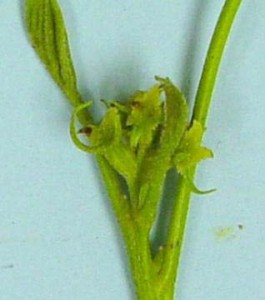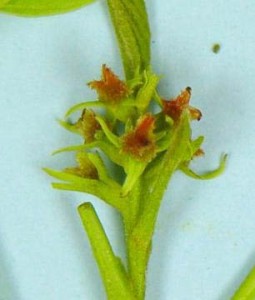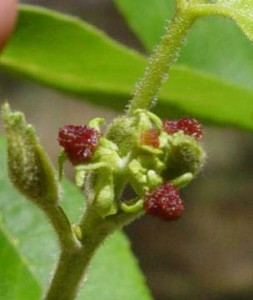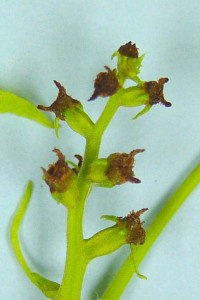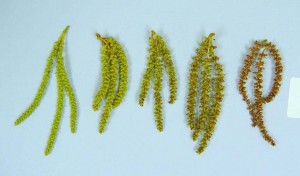Based on the calls I’ve received, the occurrence of last week’s prolonged rainfall during the pecan flower bloom has many growers concerned that the weather had a negative effect on pecan pollination. While, cool, rainy conditions are certainly poor conditions for pecan pollination, I think we are still in pretty good shape. Most of the female flowers I was seeing last week where not yet receptive, and the catkins or male flowers of some type I varieties were just beginning to mature and release some pollen. This week’s weather is much more conducive to pollination and it looks as though the female flowers of many varieties are receptive this week as the pollen begins to fly.
Its a common misconception that the stigma color of the female flower tells you when the flower has been pollinated. While the stigmas do turn dark brown, color can be misleading. It all depends on what you see as “brown”. Stigma color varies with variety as you can see from the images below:
Moreland Kiowa Pawnee
Many varieties have a burgundy stigma color that to the eyes of some may be considered brown. All of the stigmas you see in the image above are receptive, even thought he Kiowa and Pawnee flowers have a brownish appearance. The real key to determining whether or not the female flowers are still receptive is found in their texture. Receptive flowers have a waxy or shiny appearance, while flowers which have reached beyond the receptive stage appear dry or dull as in the photo below:
Female flowers are usually receptive for 5-12 days. When humidity is low and winds are warm, the stigma has a tendency to dry out early, limiting receptivity. High humidity in the form of rain or fog may limit pollen shed.
The appearance of catkins can tell you when they have developed beyond maturity. As the catkins mature, they begin to take on a brownish tinge. When the first hint of brown begins to become noticeable, some of the pollen is nearing maturity and beginning to shed. This tinge will darken as the catkins continue to mature.
Immature Shedding Past Maturity
Pollen maturity can be easily tested by shaking a few catkins in your hand. If the pollen is mature, the yellow pollen grains will shake out into your hand. After the catkin has completed maturity and released its pollen it will turn dark brown and dry.
So, in the Southern half of our state’s pecan belt, this is a big week for pollination of many varieties. As you go north, female flowers and catkins are getting close as well. We have a long way to go with this season, but our crop potential looks pretty good at this point if we continue with good weather conditions over the next couple of weeks and we can win the battle with pecan scab over the course of the season.
A special thanks to Dr. Patrick Conner for use of the photos in this post.

